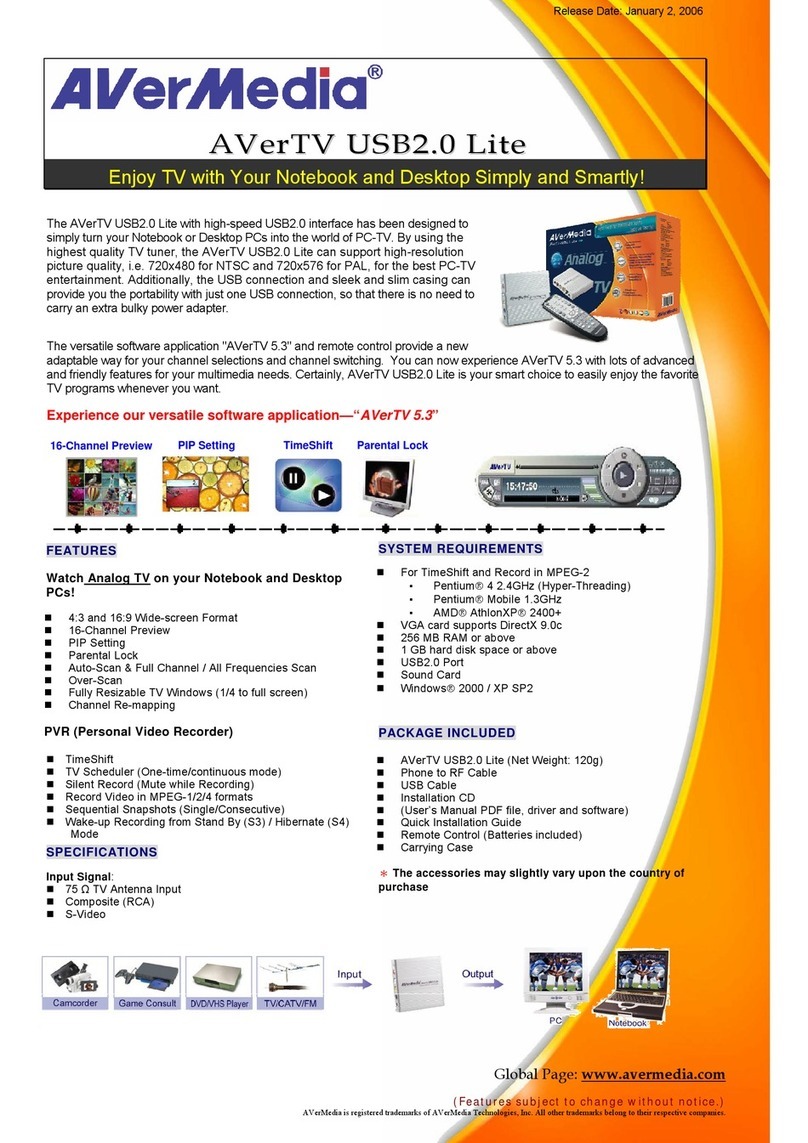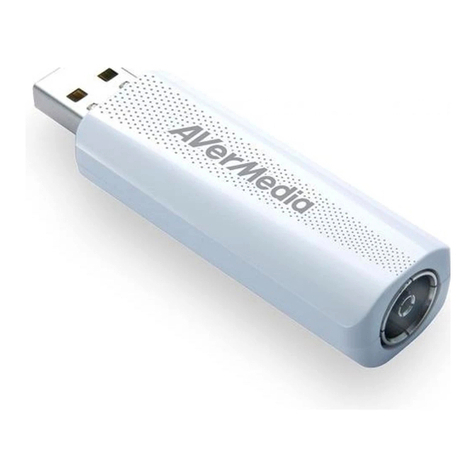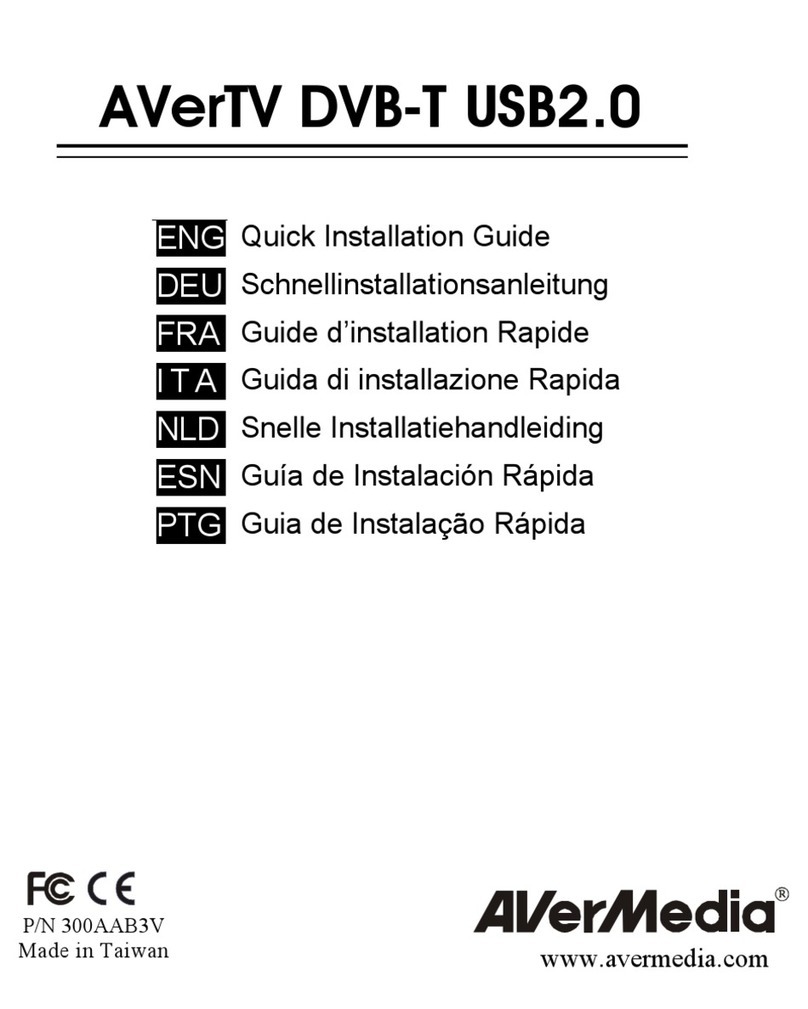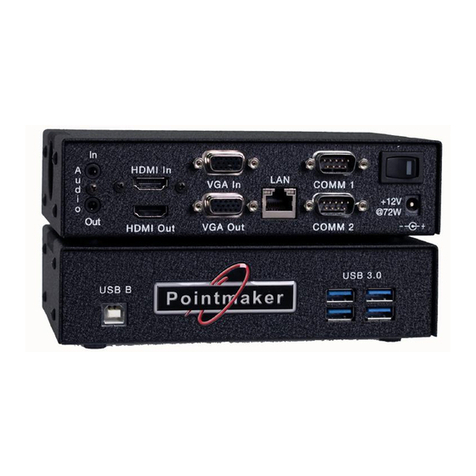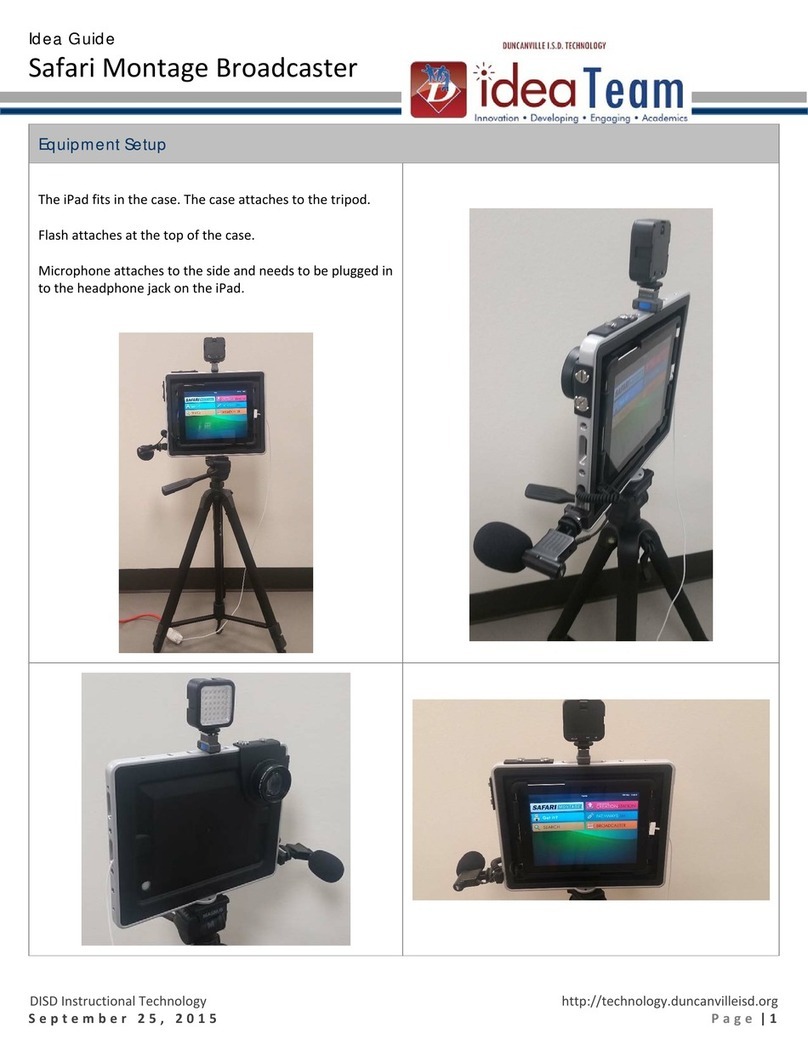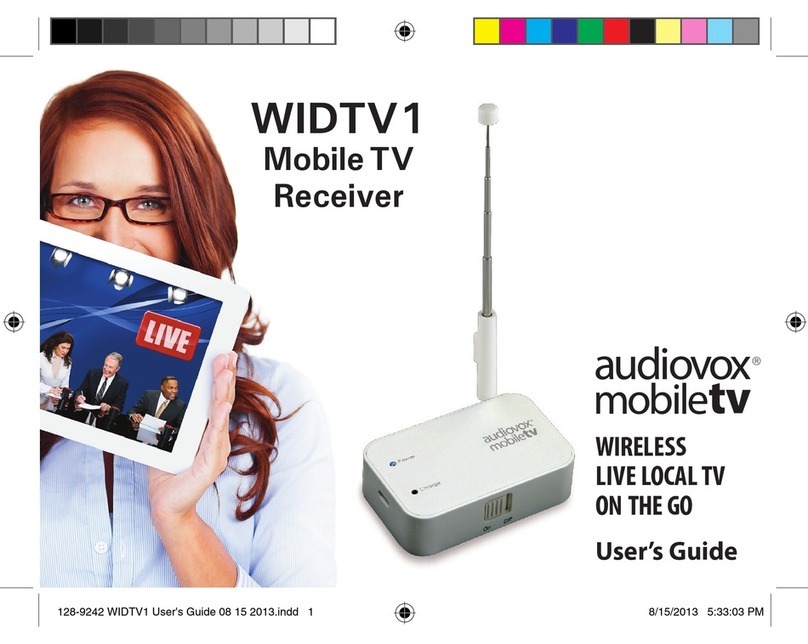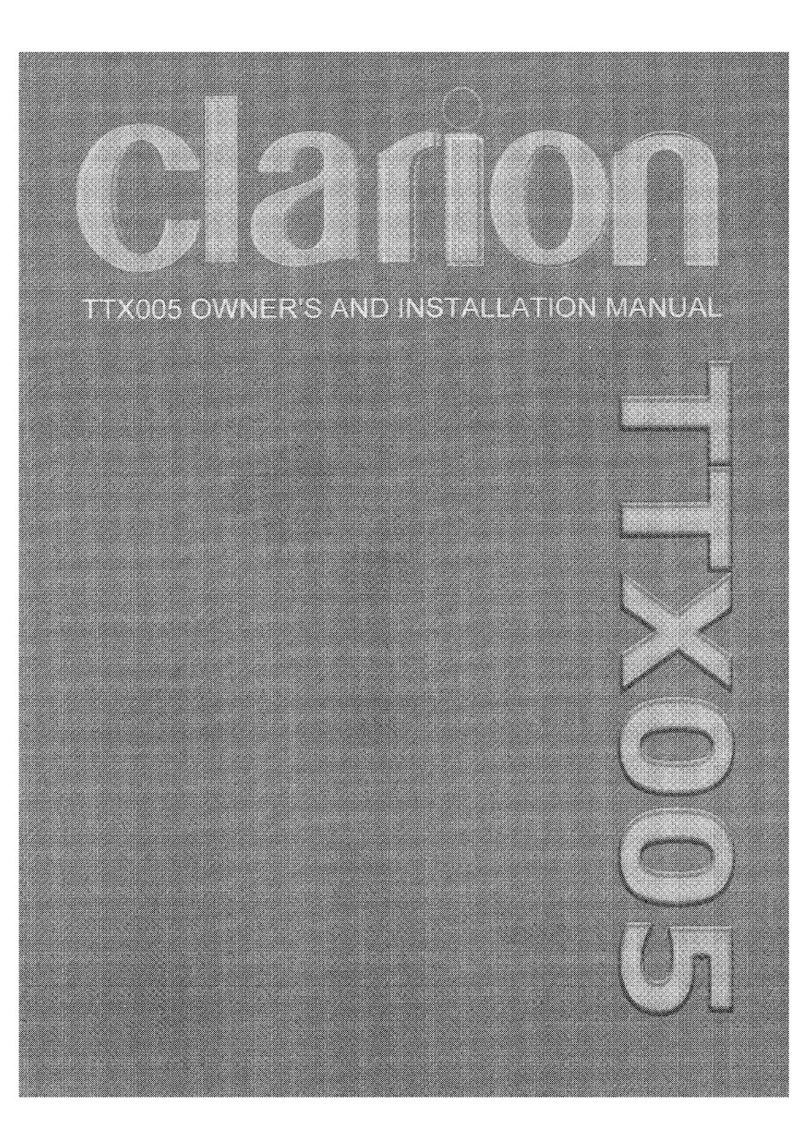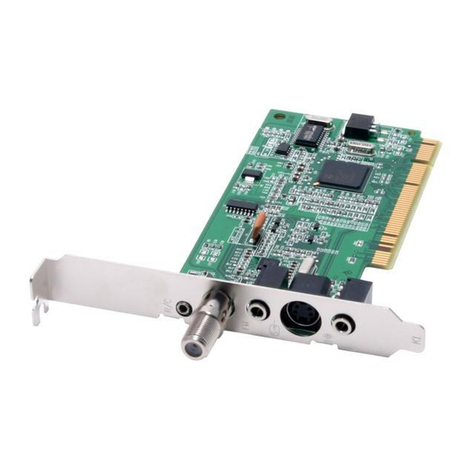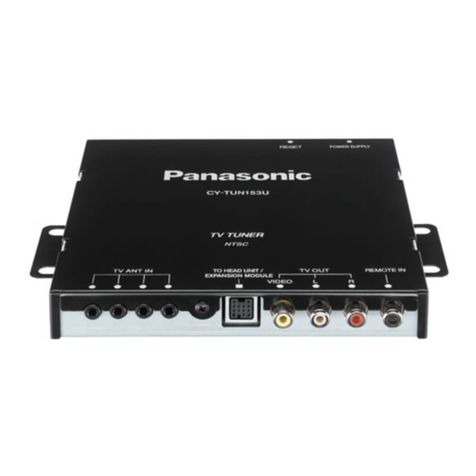SiliconDust HDHomeRun TECH Parts list manual

HDHomeRun TECH Usage Guide
(20121008)

I. Hardware:
Fron
1. Power LED
2. Network LED
3. Tuner0 LED
4. Tuner1 LED
Back
6. Power connector
7. Network connector
8. Tuner1
9. Tuner0
Power:
The HDHomeRun TECH should be used w th the suppl ed 5V 1A power adapter.
E herne :
The HDHomeRun TECH can be connected to a network sw tch (100baseT or G gab t), or can be
connected d rectly to a computer/laptop Ethernet port.
D rect-connect: The Ethernet port on the HDHomeRun TECH s Auto-MDX (auto-crossover) and
does not requ re a cross-over cable when connected d rectly to a computer/laptop.
Tuners/RF:
Each tuner on the HDHR-TECH-US supports 8VSB, QAM256 (ITU Annex B), and QAM64 (ITU
Annex B) w th an RF range of 55-861MHz (cable channels 1 to 135).
The s gnal level for d g tal cable must be n the range of -12dBmV to +40dBmV. Lower s gnal
levels can be measured.
1 2 3 4 5 6 7 8 9

II.Sof ware Ins alla ion
The latest HDHomeRun dr vers, code, and f rmware can be found on the S l condust webs te:
http://www.s l condust.com/downloads
The HDHomeRun TECH requ res the HDHomeRun Software release 20091024 or newer.
Windows:
Download and nstall the latest W ndows release of the HDHomeRun software.
The nstallat on process w ll automat cally detect and upgrade the f rmware n any HDHomeRun
TECH un ts detected on the local subnet.
The HDHomeRun Setup w zard s opt onal.
When the nstallat on process s complete t s recommended that the HDHomeRun program
d rectory be added to the PATH so that the hdhomerun_conf g ut l ty can be run from a cmd
prompt. The default program d rectory s “C:\Program F les\S l condust\HDHomeRun\”
Linux/*BSD/Solaris:
Download and extract the l bhdhomerun arch ve.
Run "make" to comp le hdhomerun_conf g.
Copy hdhomerun_conf g to /usr/local/b n
QuickTV:
Qu ckTV s the S l condust v deo player for W ndows. It s nstalled as part of the complete
W ndows software or can be nstalled stand-alone on cl ents for mult cast v ew ng.
VideoLAN VLC:
V deoLAN VLC s a th rd party v deo player su table for use w th the HDHomeRun TECH:
http://www.v deolan.org/vlc/
TSReader:
TSReader s a th rd party Transport Stream analyzer for W ndows that works w th the
HDHomeRun TECH:
http://www.coolstf.com/tsreader/

III.Ini ial Configura ion
Computer IP address configuration:
If the HDHomeRun TECH s connected d rectly to a computer (no DHCP server) the computer w ll
need to be conf gured such that t has a 169.254.x.x IP address (subnet 255.255.0.0). Th s can be
ach eved by stat cally conf gur ng a 169.254.x.x IP address, or by the computer ass gn ng tself an
AutoIP address.
W ndows: W ndows w ll p ck an AutoIP address after a per od of t me f conf gured to “obta n an IP
address automat cally”. Th s takes 3 m nutes on XP and 30 seconds on V sta. Sett ng a stat c
169.254.x.x IP address w ll avo d th s delay.
The HDHomeRun w ll take 20 seconds from l nk-up unt l t can be addressed us ng an AutoIP
address.
Default IP Address:
By default the HDHomeRun TECH w ll attempt to acqu re an IP address us ng DHCP, as well as
choos ng an AutoIP address n the 169.254.x.x range.
If The HDHomeRun TECH s on the same DHCP-managed subnet as the computer or s connected
d rectly to the computer then the un t can be addresses by Dev ce ID. It s not necessary to know
the IP address.
Methods to determ ne the IP address of the HDHomeRun TECH:
•If us ng DHCP and the computer s on the same subnet as the HDHomeRun TECH, run
“hdhomerun_conf g d scover” from a shell.
•If us ng DHCP and the computer s on a d fferent subnet then check the DHCP server logs.
The HDHomeRun TECH reports a hostname of “HDHR-XXXXXXXX” where XXXXXXXX s the
Dev ce ID pr nted on the bottom of the un t.
•If the HDHomeRun TECH s d rectly connected to the computer the computer w ll need to
be conf gured such that t has a 169.254.x.x IP address (subnet 255.255.0.0). Th s can be
ach eved by stat cally conf gur ng a 169.254.x.x IP address, or by the computer ass gn ng
tself an AutoIP address. Run “hdhomerun_conf g d scover” from a shell.
•If the HDHomeRun TECH has been prev ously conf gured w th a stat c IP address and that
IP address s no longer val d for the network then connect the HDHomeRun TECH d rectly
to a computer and use the d rect-connect techn que to commun cate w th the un t.
Setting the IP address:
DHCP local subnet:
The HDHomeRun TECH can be addressed by dev ce ID f t s on the same DHCP-managed subnet
as the computers that w ll be controll ng t. It s not necessary to set an IP address.
DHCP Fixed assignment:
Most DHCP servers can be conf gured to ass gn a set IP address to a spec f c dev ce. The
HDHomeRun TECH can be dent f ed by the DHCP server by MAC address or by hostname. The
hostname w ll be reported as “HDHR-XXXXXXXX” where XXXXXXXX s the Dev ce ID pr nted on
the bottom of the un t. The MAC address s pr nted on the bottom of the un t.

Static IP assignment:
A stat c IP address can be conf gured us ng the follow ng command (the quotes are requ red as
shown):
Format: hdhomerun_config <old ip> set /sys/ipaddr “<new ip> <subnet> <gateway>”
Example: hdhomerun_config 69.254.34.98 set /sys/ipaddr “ 0. 0.20.43 255.255.255.0 0. 0.20. ”
Note: The TECH requ res a gateway when used to stream mult cast, even f on the same subnet.
everting to DHCP:
The HDHomeRun TECH can be conf gured for DHCP operat on (default) us ng the follow ng
command:
Format: hdhomerun_config <old ip> set /sys/ipaddr dhcp
Example: hdhomerun_config 69.254.34.98 set /sys/ipaddr dhcp
Setting the channel map:
The channel map s a non-volat le conf gurat on opt on that s used to set the channel to frequency
table, to conf gure the channel scan table, and to opt m ze the auto-modulat on detect on.
GUI: The channel map can be set for each tuner by runn ng HDHomeRun Conf g (GUI).
Command l ne: The channel map can be set for each tuner us ng the follow ng command:
Format: hdhomerun_config <ip|id> set /tuner<n>/channelmap <channelmap>
Example: hdhomerun_config 000 000 set /tuner0/channelmap us-cable
Example: hdhomerun_config 000 000 set /tuner /channelmap us-cable
Channel maps supported by HDHR-TECH-US hardware:
Name Descrip ion Loca ion
us-bcast Digital Antenna (AT C). U , Canada
us-cable Digital Cable - Normal frequency layout. U , Canada
us-hrc Digital Cable - HRC frequency layout. U , Canada
us-irc Digital Cable - IRC frequency layout. U , Canada
Channel maps supported by HDHR-TECH-EU hardware:
Name Descrip ion Loca ion
au-bcast Digital Antenna (Australia). Australia
au-cable Digital Cable (Australia). Australia
eu-bcast Digital Antenna (Europe). Europe, New Zealand
eu-cable Digital Cable (Europe). Europe, New Zealand
tw-bcast Digital Antenna (Taiwan). Taiwan
tw-cable Digital Cable (Taiwan). Taiwan

IV.HDHomeRun Config (GUI)
HDHomeRun Conf g (GUI) s a GUI ut l ty for check ng s gnal level and/or prev ew ng channels.
Windows: The default v ewer appl cat on s HDHomeRun Qu ckTV. Th s can be changed to
W ndows Med a Player or VLC n HDHomeRun Setup.
Step 1: Select a HDHomeRun TECH tuner.
Step 2: Select the des red channel map.
Step 3: Select the des red channel. The scan up/down buttons w ll automat cally stop on the next
d g tal channel found.
The HDHomeRun TECH should auto-detect all programs (sub-channels) present on the selected
channel.
To v ew a program select the des red program and cl ck V ew.
To v ew the constellat on plot for the channel cl ck Plot (W ndows only).
8VSB Constellation plot QAM64 Constellation plot QAM256 Constellation plot

V.Scrip ing
The HDHomeRun can be scr pted us ng the hdhomerun_conf g command l ne ut l ty.
Th s ut l ty s cross-platform:
●W ndows, L nux, Mac, *BSD, Solar s.
●32-b t or 64-b t operat ng systems.
●B g-end an and l ttle-end an CPUs.
●PC or embedded platforms.
Using hdhomerun_config
The l st of supported commands can be obta ned by runn ng hdhomerun_conf g w thout any
parameters:
hdhomerun_config discover
hdhomerun_config <id> get help
hdhomerun_config <id> get <item>
hdhomerun_config <id> set <item> <value>
hdhomerun_config <id> scan <tuner> [<filename>]
hdhomerun_config <id> save <tuner> <filename>
hdhomerun_config <id> upgrade <filename>
Discover he HDHomeRun devices on he ne work:
The d scover command w ll f nd HDHomeRun dev ces that are on the same subnet as the host:
hdhomerun_config discover
Sending commands o a specific HDHomeRun:
The “< d>” shown above represents a un que dent f er for a HDHomeRun dev ce, th s can be
e ther Dev ce ID, or IP address:
hdhomerun_config <device id> get help
hdhomerun_config <ip address> get help
To address by Dev ce ID the HDHomeRun must be on the same subnet as the host.
A Dev ce ID of FFFFFFFF can be used as a w ld card for the f rst HDHomeRun dev ce found on the
network. Do not use th s syntax f there are mult ple HDHomeRun dev ces on the network, as the
dev ce used w ll be random based on d scovery order, wh ch may change between commands.

Query he lis of op ions suppor ed by a HDHomeRun device:
The get/set opt ons supported by a spec f c HDHomeRun dev ce can be quer ed us ng the get help
command:
hdhomerun_config <id> get help
Example output:
Supported configuration options:
/tuner<n>/channel <modulation>:<freq|ch> Get/set modulation and frequency
/tuner<n>/channelmap <channel map> Get/set channel to frequency map
/tuner<n>/filter 0x<nnnn>-0x<nnnn> [...] Get/set PID filter
/tuner<n>/program <program number> Get/set MPEG program filter
/tuner<n>/target <ip>:<port> Get/set target IP for tuner
/tuner<n>/status Display status of tuner
/tuner<n>/streaminfo Display stream info
/tuner<n>/debug Display debug info for tuner
/tuner<n>/lockkey Set/clear tuner lock
/sys/model Display model name
/sys/features Display supported features
/sys/version Display firmware version
/sys/copyright Display firmware copyright
/sys/debug Display debug info
Channel scan:
To run a channel scan:
Format: hdhomerun_config <id> scan /tuner<n> [log filename]
Example: hdhomerun_config FFFFFFFF scan /tuner0 scan0.log
Th s command w ll scan all channels on the selected channel map plus any add t onal channel
maps assoc ated w th the selected channel map. All standard modulat on types for the selected
channel map are tested.
When a d g tal channel s found t w ll dent fy the programs on the channel.
The log f lename s opt onal; f ncluded t w ll log to the g ven f lename.
Tuning a physical channel:
To set a channel use the set channel command:
Format: hdhomerun_config <id> set /tuner<n>/channel <modulation>:<frequency>
Format: hdhomerun_config <id> set /tuner<n>/channel <modulation>:<channel>
Example: hdhomerun_config FFFFFFFF set /tuner0/channel auto:65 000000
Example: hdhomerun_config FFFFFFFF set /tuner0/channel auto:60
To auto-detect the modulat on type use “auto” for the modulat on.
Supported modulat on types can be quer ed w th the get sys-features command:
hdhomerun_config <id> get /sys/features
To stop the tuner set the channel to none:
Format: hdhomerun_config <id> set /tuner<n>/channel none
Example: hdhomerun_config FFFFFFFF set /tuner0/channel none
Checking he signal s reng h:
The bas c s gnal nformat on can be obta ned by us ng the get status command:
Format: hdhomerun_config <id> get /tuner<n>/status
Example: hdhomerun_config FFFFFFFF get /tuner0/status

Example output:
ch=qam:33 lock=qam256 ss=83(- 0dBmV) snq=90(29dB) seq= 00 bps=388077 2 pps=0
●ch = channel requested
●lock = actual modulat on detected
●ss = s gnal strength.
●snq = s gnal to no se qual ty (MER).
●seq = symbol error qual ty (based on the number of uncorrectable d g tal errors detected).
●bps = raw channel b ts per second.
●pps = packets per second sent through the network.
More advanced nformat on can be obta ned by us ng the get debug command:
Format: hdhomerun_config <device id> get /tuner<n>/debug
Example: hdhomerun_config FFFFFFFF get /tuner0/debug
Example output:
tun: ch=qam:33 lock=qam256 ss=84 snq=88 seq= 00 dbg=2208 -6930
dev: resync=0 overflow=0
ts: bps=388092 6 ut=94 te=0 miss=0 crc=0
flt: bps=388092 6
net: pps=0 err=0 stop=0
Each l ne conta ns a pref x to nd cate the type of data, followed by the values.
●tun = tuner status
○see above sect on
●dev = dev ce status
●ts = transport stream
○bps = b ts per second
○ut = ut l zat on percentage (100% s f lled to capac ty)
○te = transport error counter (uncorrectable recept on error)
○m ss = m ssed packet counter (jump n sequence numbers)
○crc = crc error counter
●flt = results after p d f lter ng
○bps = b ts per second
●net = network status
○pps = packets per second
○err = packets or TS frames dropped before transm ss on.
○stop = reason for stopp ng the stream
The counters are reset to zero upon a channel change, but may nd cate a small number of errors
caused before the tuner locks on the channel. As a result, d agnost cs should be based on the
change n values over t me, and not the n t al values.

De ec ing he programs on a physical channel:
The HDHomeRun w ll detect the programs (sub-channels). Use the get stream nfo command to
query the detected programs:
Format: hdhomerun_config <id> get /tuner<n>/streaminfo
Example: hdhomerun_config FFFFFFFF get /tuner0/channel streaminfo
The output format s:
<program number>: <virtual major>.<virtual minor> [<name>] [(<flags>)]
Example output:
3: 20. KBWB-HD
4: 20.4 AZTECA
D g tal cable does not always prov de the channel name or v rtual channel number:
: 0.0
2: 0.0 (encrypted)
3: 0.0 (control)
It may take several seconds after sett ng the channel for the stream nformat on to be fully
populated (depend ng on how long the channel takes to lock and how often the stream
nformat on s sent by the broadcaster/cable prov der).
Fil ering by program (sub-channel):
The HDHomeRun supports automat c PID f lter ng by program number or v rtual channel number:
Format: hdhomerun_config <id> set /tuner<n>/program <program number>
hdhomerun_config <id> set /tuner<n>/program <virtual channel number>
Example: hdhomerun_config FFFFFFFF set /tuner0/program 3
hdhomerun_config FFFFFFFF set /tuner0/program .2
When f lter ng by program the MPEG TS tables are generated by the HDHomeRun. The result s a
val d s ngle-program transport stream.
The program f lter s cleared when a set channel or a set f lter command s rece ved.
Advanced: By default the PAT and PMT are generated. To also generate a ATSC-style TVCT use:
hdhomerun_config <id> set /tuner<n>/program "<program number> tvct_from_pmt=<virtual major>.<virtual
minor>(<name>)"
Example: hdhomerun_config <id> set /tuner0/program "3 tvct_from_pmt= .2(TEST)"

Fil ering by PID:
The HDHomeRun supports arb trary hardware PID f lter ng:
Format: hdhomerun_config <id> set /tuner<n>/filter <filter>
Example: hdhomerun_config FFFFFFFF set /tuner0/filter "0x0000-0x FFF"
hdhomerun_config FFFFFFFF set /tuner0/filter "0x0000 0x0030-0x0033 0x FFB"
When f lter ng by PID the stream s f ltered but otherw se unmod f ed.
The f lter s cleared to pass-all (0x0000-0x1FFF) when a set channel command s rece ved.
Saving a s ream:
The hdhomerun_conf g command can be used to automate the process of sav ng to the local
f lesystem:
Format: hdhomerun_config <id> save /tuner<n> <filename>
Example: hdhomerun_config FFFFFFFF save /tuner0 capture.ts
Wh le sav ng the stream, a s ngle per od “.” w ll be d splayed every second. Errors w ll be nd cated
by a letter.
Example output:
............n...............................n..........ts..........
-- Video statistics --
23323 packets recieved, 2 network errors, transport errors, sequence errors
Advanced: A f lename of “null” nd cates no f le should be created, allow ng the use of the save
command as a d agnost c tool.
Advanced: “-” may be used as a f lename to nd cate standard output, allow ng the save
command to be used as a p pe on supported platforms.
Example: hdhomerun_config FFFFFFFF save /tuner0 - | vlc -
S reaming o a arge machine:
Set the target IP address and port number us ng the set target command:
Format: hdhomerun_config <id> set /tuner<n>/target udp://<ip>:<port>
Format: hdhomerun_config <id> set /tuner<n>/target rtp://<ip>:<port>
Example: hdhomerun_config FFFFFFFF set /tuner0/target udp:// 92. 68. . 00:5000
Example: hdhomerun_config FFFFFFFF set /tuner0/target rtp:// 92. 68. . 00:5000
The target mach ne must be l sten ng on the g ven UDP port. The HDHomeRun w ll automat cally
clear the target f a ICMP port unreachable message s rece ved.
A global broadcast (255.255.255.255), subnet broadcast, or mult cast target can be spec f ed
however care must be taken to ensure that the traff c w ll not cause problems w th other dev ces
on the network. If the local network s br dged to a w reless network then the AP w ll typ cally
transm t at a low broadcast speed saturat ng the w reless network.
The t me-to-l ve (TTL) defaults to 64. To conf gure a lower TTL use the follow ng format (quotes
requ red):
Format: hdhomerun_config <id> set /tuner<n>/target “udp://<ip>:<port> ttl=<n>”
Format: hdhomerun_config <id> set /tuner<n>/target “rtp://<ip>:<port> ttl=<n>”
Example: hdhomerun_config FFFFFFFF set /tuner0/target “udp:// 92. 68. . 00:5000 ttl=8”
Example: hdhomerun_config FFFFFFFF set /tuner0/target “rtp:// 92. 68. . 00:5000 ttl=8”

Example: S reaming o VLC:
Run VLC: Med a, Open Network Stream. Select UDP/RTP. Spec fy port 5000.
D scover the HDHomeRun:
hdhomerun_config discover
Run a channel scan:
hdhomerun_config FFFFFFFF scan /tuner0 scan0.log
Set the phys cal channel:
hdhomerun_config FFFFFFFF set /tuner0/channel auto:65 000000
Check sub-programs:
hdhomerun_config FFFFFFFF get /tuner0/streaminfo
Select a sub-program:
hdhomerun_config FFFFFFFF set /tuner0/program 3
Set the target:
hdhomerun_config FFFFFFFF set /tuner0/target udp://<ip address of pc>:5000
Datacast operation
HDHomeRun Tech un ts support Datacast TCP/IP over OTA broadcast.
Example:
D scover the HDHomeRun:
hdhomerun_config discover
Set the phys cal channel:
hdhomerun_config FFFFFFFF set /tuner0/channel auto:65 000000
Set the datacast PID:
hdhomerun_config FFFFFFFF set /tuner0/filter 0x0A00
Set the target:
hdhomerun_config FFFFFFFF set /tuner0/target datacast
Using /sys/boot
The /sys/boot var able allows the HDHomeRun Tech un t to automat cally set var ables at startup,
allow ng you to preserve sett ngs across power outages or s mply set the power on defaults.
The syntax for the /sys/boot cons sts of mult ple l nes of text; a var able name followed by a s ngle
space and then the value: (there should not be any space before the var able name)
<variable > <value of variable >
<variable2> <value of variable2>
...
<variableN> <value of variableN>
Example (save as boot.txt):
/tuner0/channelmap us-cable
/tuner0/channel 03

/tuner0/program 4
To store the conf gurat on to the HDHomeRun:
Format: hdhomerun_config <id> set /sys/boot - < filename
Example: hdhomerun_config FFFFFFFF set /sys/boot - < boot.txt
Changes w ll be appl ed the next boot; to execute the new /sys/boot mmed ately:
Format: hdhomerun_config <id> execute
Example: hdhomerun_config FFFFFFFF execute

VI.Mul icas
The HDHomeRun TECH supports mult cast stream ng w th n a network.
Configuring the HDHome un TECH:
1) Us ng HDHomeRun Conf g GUI or hdhomerun_conf g choose a des red channel and
program number for each tuner. In th s example we w ll use channel 19 program 3 on
tuner 0 and channel 30 program 1 on tuner 1.
2) Choose a mult cast IP address for each stream. As a general rule the mult cast address
should be n the range of 239.255.0.0 to 239.255.255.255. In th s example we w ll use
239.255.1.1 and 239.255.1.2
3) Choose a dest nat on (cl ent) port number. The port should be outs de the the well-known
ports range (we recommend 50000+) and should be un que for each stream. In th s
example we w ll use 59001 and 59002.
4) Wr te the boot scr pt (text f le):
/tuner0/channelmap us-bcast
/tuner0/channel 9
/tuner0/program 3
/tuner0/target rtp://239.255. . :5900 ttl=64
/tuner /channelmap us-bcast
/tuner /channel 30
/tuner /program
/tuner /target rtp://239.255. .2:59002 ttl=64
5) Wr te the boot scr pt to the HDHomeRun:
hdhomerun_config 00 0003 set /sys/boot - < boot.txt
6) Execute the boot scr pt:
hdhomerun_config 00 0003 execute
7) Check the tuner status and target for each tuner. The packets-per-second “pps” number
should be non-zero nd cat ng that the HDHomeRun s send ng the stream.
hdhomerun_config 00 0003 get /tuner0/debug
hdhomerun_config 00 0003 get /tuner0/target
hdhomerun_config 00 0003 get /tuner /debug
hdhomerun_config 00 0003 get /tuner /target

HDHome un QuickTV (Windows):
HDHomeRun Qu ckTV s a l ghtwe ght v ewer su table for play ng mult cast v deo from the
HDHomeRun TECH. HDHomeRun Qu ckTV s nstalled w th the full HDHomeRun software or can be
nstalled stand-alone us ng the separate HDHomeRun Qu ckTV nstaller.
HDHomeRun Qu ckTV uses a “.qtv” channel f le to support fr endly select on between mutl cast
channels. Th s f le would typ cally be placed on a f le server or ntranet download page where t
can be accessed by users.
F le format (example):
<?xml version=".0" standalone="yes"?>
<QtvLineup>
<Program>
<Name>KOFYDT</Name>
<Number>20. </Number>
<Url>hdhomerun://239.255. . :5900 /current</Url>
</Program>
<Program>
<Name>KQEDDT</Name>
<Number>9. </Number>
<Url>hdhomerun://239.255. .2:59002/current</Url>
</Program>
</QtvLineup>
Name the f le w th a “.qtv” extens on and then double-cl ck to launch Qu ckTV.
Qu ckTV should d splay the channel l st and start play ng when a channel s selected.
VideoLAN VLC:
V deoLAN VLC s a 3rd party cl ent su table for play ng mult cast v deo from the HDHomeRun TECH.
•Run VLC and select Med a, Open Network.
•Set the protocol to RTP.
•Set the address to 239.255.1.1 and the port to 59001.
•Cl ck play.

FCC No ice (US TECH models):
Th s dev ce compl es w th part 15 of the FCC Rules. Operat on s subject to the cond t on that th s
dev ce does not cause harmful nterference.
Note: Th s equ pment has been tested and found to comply w th the l m ts for a Class B d g tal
dev ce, pursuant to part 15 of the FCC Rules. These l m ts are des gned to prov de reasonable
protect on aga nst harmful nterference n a res dent al nstallat on. Th s equ pment generates,
uses and can rad ate rad o frequency energy and, f not nstalled and used n accordance w th the
nstruct ons, may cause harmful nterference to rad o commun cat ons. However, there s no
guarantee that nterference w ll not occur n a part cular nstallat on. If th s equ pment does cause
harmful nterference to rad o or telev s on recept on, wh ch can be determ ned by turn ng the
equ pment off and on, the user s encouraged to try to correct the nterference by one or more of
the follow ng measures:
—Reor ent or relocate the rece v ng antenna.
—Increase the separat on between the equ pment and rece ver.
—Connect the equ pment nto an outlet on a c rcu t d fferent from that to wh ch the rece ver s
connected.
—Consult the dealer or an exper enced rad o/TV techn c an for help.
FCC No ice (US HDRACK models):
Th s dev ce compl es w th Part 15 of the FCC Rules. Operat on s subject to the follow ng two
cond t ons: 1) Th s dev ce may not cause harmful nterference. 2) Th s dev ce must accept any
nterference rece ved, nclud ng nterference that may cause undes red operat on.
Th s product has been tested and found to comply w th the l m ts for a Class A d g tal dev ce
pursuant to Part 15 of the FCC Rules. These l m ts are des gned to prov de reasonable protect on
aga nst harmful nterference when the equ pment s operated n a commerc al env ronment. Th s
product generates, uses, and can rad ate rad o frequency energy and, f not nstalled and used n
accordance w th the manufacturer’s nstruct on manual, may cause harmful nterference w th rad o
commun cat ons. Operat on of th s product n a res dent al area s l kely to cause harmful
nterference, n wh ch case you w ll be requ red to correct the nterference at your own expense.
Trademarks:
HDHomeRun s a reg stered trademark of S l condust USA Inc.
HDRACK s a trademark of S l condust USA Inc.
This manual suits for next models
1
Table of contents
Other SiliconDust TV Tuner manuals

